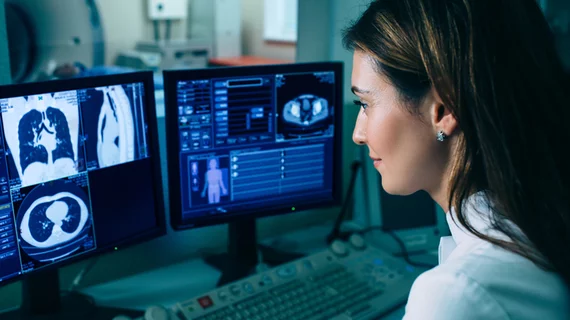17 short-term strategies to address the national radiologist shortage
An article in the American Journal of Roentgenology (AJR) outlines 17 ways to reduce the impact of the growing national shortage of radiologists.[1]
"Our focus was on systematically identifying potential short-term interventions and their impact," wrote lead author James V. Rawson, MD, director, Radiology Center for Outcomes Research Institute, Beth Israel Medical Center, Harvard Medical School, and colleagues. "The current radiology landscape has an imbalance between the rising demand for radiology services and the national radiologist workforce available. Rather than working longer and/or faster, radiologists can work smarter."
The article presents multiple short-term strategies to increase the effective radiologist workforce or increase efficiency to alleviate the current workload challenges. Rawson, et al., said these strategies are derived from an analysis of possible practice-level changes in personnel, process and the working environment.
"This article by Rawson et al. will serve as a landmark reference for navigating short-term labor challenges in radiology," explained Khushboo Jhala, MD, MBA, Brigham and Women’s Hospital, who wrote an editorial about the article.[2] "The article is unique in that it provides theoretic examples illustrating the impact of each approach, which is a conceptual scaffold used in scenario planning. For example, in the category of people, the authors determined that if all 4,352 national part-time radiologists increased their work by one additional day per month, the equivalent of 261 additional radiologists would be added to the national workforce."
"This article should stimulate practices to systematically try specific strategies and evaluate outcomes on the basis of objective metrics such as radiologist job satisfaction, burnout, rate of turnover, or rate of retirement. Practices can discard ineffective strategies and increase efforts on successful strategies that augment their workforce," explained Jay R. Parikh, MD, FACR, a professor at University of Texas MD Anderson Cancer Center, explained in a second editorial.[3]
Where to find additional people to aid radiology:
• Retired radiologists are an untapped workforce that might have interest in part-time positions, per diem work and phased retirements.
• Part-time radiologists could be enticed to work just a couple more hours. An estimated 16% of the radiology workforce is currently part time, including about 28% of female radiologists who are looking for more home-work life balance.
• Seasonal workers are not a normal model for radiology, but could be adopted in locations impacted by temporary volume increases, such as during flu season, an influx of tourists or snowbirds, or anticipated increased volumes during breast cancer awareness month.
• Fellowship trainees who completed radiology residency can be members of the hospital medical staff in some settings.
• International medical graduates may qualify for the American Board of Radiology (ABR) alternate pathway for those not planning to enter a standard residency as a path to enter the U.S. radiology workforce. A working radiologist in another country can become a faculty member at a U.S. academic radiology department, with that faculty time counting toward their four years in the alternative pathway.
• Reading room assistants can provide administrative support by providing telephone coverage, calling ordering practitioners for noncritical actionable findings, and answering basic scheduling or protocol questions to free up more time for the radiologist.
• Nonphysician practitioners (NPPs) can serve as radiology extenders, such as nurse practitioners, physician assistants, advanced sonographers, “super techs,” and registered radiologist assistants. This includes a variety of roles from predicting diagnostic examinations to working up patients for and performing some minimally invasive procedures. However, NPPs have been controversial because of concerns about scope creep by non-physicians.
Redefining process suggestions to augment radiology:
• Use teleradiology services to cover evening and overnight work hours.
• Leveraging private practice radiologists who have vacation time or conference time and can moonlight at other practices.
• Internal moonlighting to encourage filling weekend and evening hour shifts.
• Develop thresholds for significant study backlogs that prompt specific actions, or institute surge pricing similar to ride share services like Uber.
• Develop ways to reduce low-value imaging exam volumes.
• Adopt technology to enable easy sharing of patient imaging when patients are transferred from another emergency department or hospital to eliminate the need for repeat exams.
The authors also suggest use of hybrid workflows, remote work, and better ergonomics in the reading room as additional ways to stem burnout and keep the radiologists practices do have.
Radiologist shortage renews interest in AUC to reduce unnecessary exams
Rawson and colleagues noted in their article that the use of appropriate use criteria (AUC) as a required field when referring physicians order imaging exams could help reduce the number of needed or low-value exams. This too would help reduce the volume of exams radiologists are required to read so they can concentrate on the exams that are more likely to yield a clear diagnosis.
The researchers noted Medicare has attempted for years without success to implement the clinical decision support required in the Protecting Access to Medicare Act legislation. They suggest efforts may be more successful locally before national progress is made.
The authors also noted that artificial intelligence (AI) to help radiologists in a variety of ways also holds a lot of promise, but this technology will probably not be an immediate short-term solution.
Long-term solutions to the radiology shortage
"In the long term, graduate medical education expansion to increase the pipeline of radiologist trainees is needed to meet the needs of the growing and aging population. Other longer-term solutions, such as shortening residency or incorporating fellowship into residency, have also been raised," the study authors said.
The article explains a lot about the trends and contributing factors that led to the current shortage of radiologists. It also goes into more detail and offers examples on how each item could help radiology. Read more in the article.

